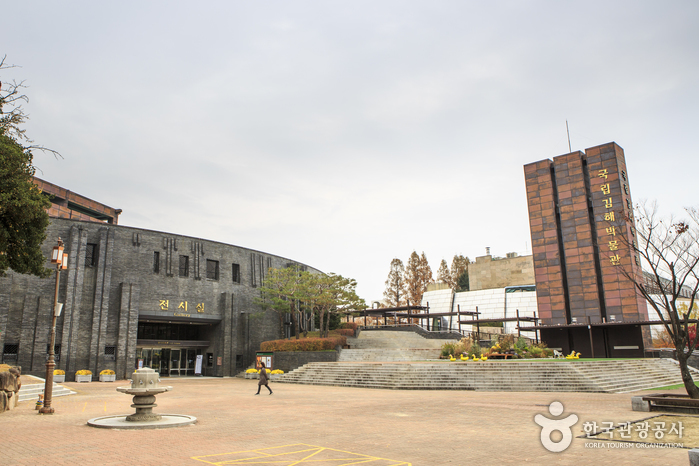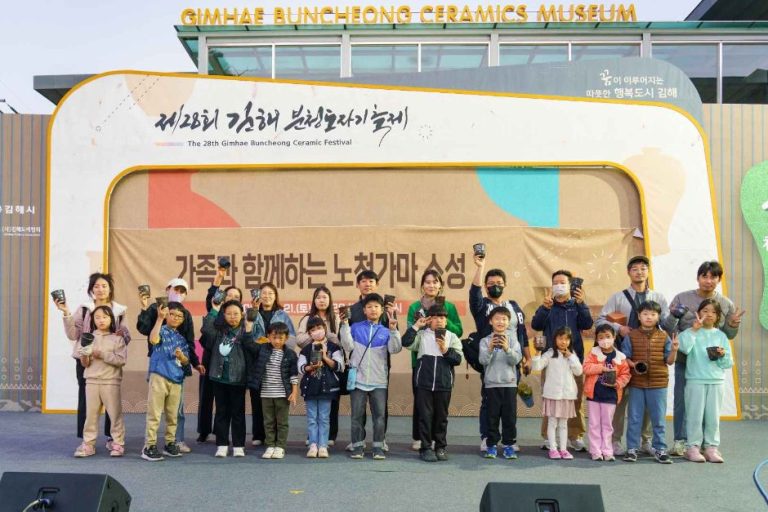Bunsanseong Fortress (김해 분산성)
Bunsanseong Fortress (김해 분산성)
– Homepage
tour.gimhae.go.kr
www.cha.go.kr
– Tel
+82-55-330-3925
Bunsanseong Fortress was constructed in the 3rd year of the reign of Goryeo’s King U (1377) by Magistrate Park Wi to defend against foreign enemies, but it was destroyed during the Japanese invasion of 1592. The fortress we see today was reconstructed by Magistrate Jeong Hyeon-seok in the 8th year of the reign of Joseon’s King Gojong (1871). However, it is estimated that it was first built during the days of Gaya. It is a temoe-style fortress with rocks piled up like a long band at the peak of Bunsan from which downtown Gimhae, Gimhae Plains, the Nakdonggang River and the South Sea are all in a single, panoramic view. Today, fortress walls remain stretching for some 900 meters on the slope towards the city and, inside the fortress, there are two gate sites in the south and north, an auxiliary gate on the west, a well site and several other building sites. The exact length of the remaining fortress walls is 929 meters and the average x_width is about 8 meters.
Inside the fortress lies Haeeunsa Temple, which was built to pay respects to Queen Heo of Garak who had come from the sea, according to stories. The temple also enshrines portraits of King Suro and Queen Heo that were painted during the Joseon dynasty. During the Japanese invasion of 1592, monk soldiers were stationed at this temple.
The fortress is more popularly called “Manjangdae” by Gimhae locals, and this name originated from the description, “A tall tower 10,000 (man) gil in x_height,” granted by Daewongun in the Joseon dynasty for this advanced base that defeats Japanese invaders. A writing of “Manjangdae” written by Daewongun himself as well as his stamp are engraved on a rock behind a beacon that was restored in 1999.
– Address : 210-162, Gaya-ro 405beon-gil, Gimhae-si, Gyeongsangnam-do
※ Presentation Information
– Age Range
Open to visitors of all ages
– Information and Guides
• 1330 Travel Hotline: +82-2-1330
(Korean, English, Japanese, Chinese)
• For more info: +82-55-330-3925
– Parking
Available
– Day Off
N/A (Open all year round)
– Operating Hours
Open 24 hr
– Admission Fees
Free
◎ Nearby Tourism Infobox
⊙ Gimhae Gaya History Park (김해가야테마파크)
View detailed guide on Korea Trip Guide →
– Homepage
https://gtp.ghct.or.kr
https://www.instagram.com/gayapark/
– Tel
+82-55-340-7900
Gimhae Gaya History Park is a resting area that provides comfortable relaxation in the daily lives of the busy people and also a cultural complex where you can experience various cultures with your family, lover and friends.
Interactive theme park combining Education + Entertainment Edutainment park where you can see, hear, touch and learn about the history of Gaya and the brilliant heritage of its people through plays, experiences and exhibits.
⊙ Gimhae Astronomical Observatory (김해천문대)
– Homepage
www.ghast.or.kr (Korean only)
– Tel
+82-55-337-3785
Gimhae Astronomical Observatory opened on February 1, 2002 as part of the Millennium Commemorative Project that started in December 1998. It was built to satisfy the general public’s curiosity about the universe and celestial bodies, inspire young people, and give everyone a unique, memorable experience. The observatory is shaped like an egg, in memory of the legend of King Kim Suro, the founder of the Garak Kingdom, according to which the king was born from an egg.
It is said that the queen of King Suro, Heo Hwang-ok, was a princess from the Indian country of Ayuta. Since sophisticated navigation equipment had yet to be invented, it can be assumed that she found her way to the Garak Kingdom by following the stars. It is also said that a prince of the Garak Kingdom built an observatory on the highest point of a mud fortress in Jinrye in order to make astronomical observations. The place is still referred to as Bibidan, which means a place to watch the stars.
These historical facts indicate the stars were very important to the Gaya, an ancient kingdom established mainly in the Gimhae area. The peak of Bunseongsan Mountain, where the observatory is located, offers sweeping views of the entire area of Gimhae. The night sky of Gimhae offers a breathtaking sight.
⊙ The Painters: The Gaya Kingdom – Gimhae(페인터즈 가야왕국-김해)
⊙ Olive Young – Inje Univ. Branch [Tax Refund Shop] (올리브영 인제대)
–
⊙ Dongsang Market (동상시장)
– Homepage
www.ds-market.co.kr
Formed in 1945, Dongsang Market is a lifestyle-centric traditional market that offers a slew of daily necessities like vegetables, fruits, rice cakes, fishery products, and side dishes, as well as a popular alley specializing in Kalguksu (noodle soup). Designated as a cultural tourism market in 2017, it has since evolved into a vibrant space where traditional Korean culture harmoniously coexists with diverse global cultures. As more foreign workers have begun frequenting the market in recent years, a number of Asian grocery stalls have opened. In particular, vegetables favored by Southeast Asian customers, ritual foods, and Kalguksu (noodle soup) have become local specialties.
⊙ Miryang Dwaeji Gukbap (밀양돼지국밥)
Miryang Dwaeji Gukbap is a renowned dwaeji gukbap (pork and rice soup) establishment located in Eobang-dong, Gimhae-si. Recognized among the top 100 recommended restaurants for Gimhae tourism by the city, this eatery has become so popular that visitors often queue to taste its offerings. Standard accompaniments include buchu muchim (chive salad), chili peppers, garlic, and kimchi. In addition to dwaeji gukbap, visitors can enjoy suyuk (boiled pork slices). Nearby attractions include Gimhae Gaya History Park, Gaya Land, and Bunseongsan Mountain.
⊙ Subaekdang Dwaejigukbap Gimhae Branch (수백당돼지국밥김해점)
– Homepage
<a href=”https://soondaeking.modoo.at” target=”_blank”>soondaeking.modoo.at</a>
Subaekdang Dwaejigukbap specializes in dwaeji gukbap (pork and rice soup) with boiled pork slices and rice in a broth simmered with pork bones. Its owner is said to have visited 96 pork soup restaurants across the country to study the taste and make the best pork and rice soup. The rich, refreshing broth made by boiling pork backbone for a long time is excellent. This restaurant also serves sundae gukbap (sundae and rice soup) made with premium Berkshire pork. The Maneul Suyuk Baekban (garlic and boiled pork slices set menu), one of its signature items, is made with pork belly that anyone loves and topped with garlic sauce.
⊙ Gimhae National Museum (국립김해박물관)

– Homepage
gimhae.museum.go.kr
The Gimhae National Museum was opened on July 29, 1998, in order to research and preserve the cultural heritage of the ancient kingdom of Gaya. The museum is at the foot of Gujibong Peak in Gimhae-si, the spot where the kingdom is believed to have been founded. The museum exhibits the cultural assets of Gaya, as well as cultural relics from the prehistoric age in the Busan and Gyeongsangnam-do areas, and the cultural heritage of Byeonhan, which was the foundation for the growth of Gaya.
The exterior of the museum is made using black bricks representing iron ore and charcoal famous during the Gaya Kingdom. There are two exhibition halls, while the walkway to the halls have approximately 1,300 artifacts in display.
⊙ Tomb of King Suro (수로왕릉)
View detailed guide on Korea Trip Guide →
– Homepage
tour.gimhae.go.kr
– Tel
+82-55-332-1094
King Suro founded the Garak Kingdom in AD 42 and married Heo Hwang-ok, a princess from the Indian country of Ayuta, in AD 48. He was the founder of the Gimhae Kim family. Heo Yeop, a Yeongnam governor, gave the tomb its current look in the 13th year of the reign of King Seonjo (1580). The tomb compound includes various buildings, including the Sungseonjeon (where the ancestral tablets of King Suro and his queen are kept), Anhyanggak, Jeonsacheong, and Jegigo, as well as stone structures, such as a sindobi (tombstone) and gongjeokbi (monument established to pay homage the deceased). The tombstone in front of the royal tomb was built in the 25th year of the reign of King Injo (1647) of the Joseon dynasty. The name Sungseonjeon was bestowed on the tomb by King Gojong in the 21st year of his reign (1884).
![Lotte Mart – Geoje Branch [Tax Refund Shop] (롯데마트 거제점)](https://ktrip.blogsailing.com/wp-content/uploads/2025/11/2887949_image2_1-768x576.jpg)
![Munsingwear – Shinsegae Masan Branch [Tax Refund Shop] (먼싱웨어 신세계점)](https://ktrip.blogsailing.com/wp-content/uploads/2025/11/2890963_image2_1-768x576.jpg)
![Daks – Lotte Gimhae Branch [Tax Refund Shop] (닥스 롯데김해)](https://ktrip.blogsailing.com/wp-content/uploads/2025/11/2886046_image2_1-768x576.jpg)
![Uniqlo – Lotte Mall Jinju Branch [Tax Refund Shop] (유니클로 롯데몰진주)](https://ktrip.blogsailing.com/wp-content/uploads/2025/11/2886329_image2_1-768x576.jpg)

One Comment